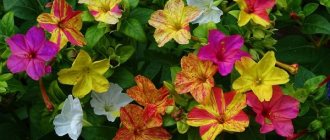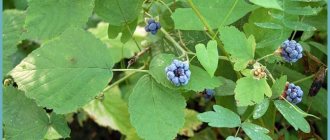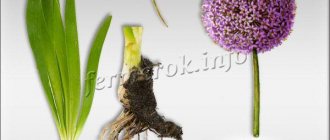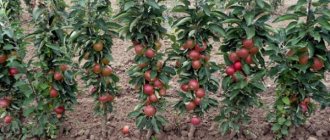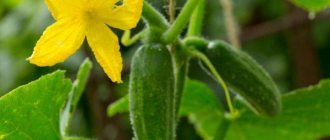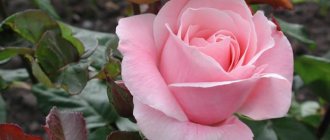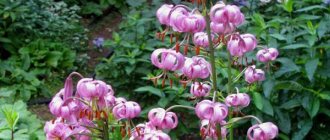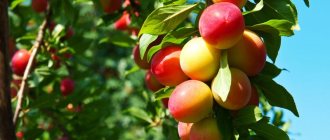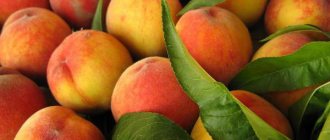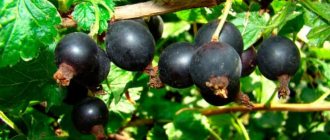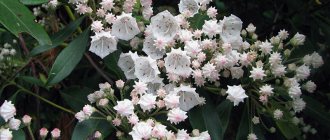We select a place and soil for planting seedlings
Actinidia kolomikta is an aggressor; its roots actively spread to the sides and can inhibit the root systems of nearby growing plants. The distance to the nearest neighbors must be at least three meters. To protect other crops, you can protect kolomikta seedlings with pieces of slate dug into the ground. When planting, the following factors affecting the development and fruiting of the plant should be taken into account:
- It is not recommended to plant the vine near water bodies, as the plant does not like waterlogging. Experienced gardeners do not recommend planting kolomikta in areas with high groundwater levels.
- The shoots of Actinidia kolomikta stretch towards the sun, but the roots do not tolerate drying out and overheating at all, since they are located superficially. Because of these features, you should choose a semi-shaded place for planting.
- Actinidia kolomikta prefers loose and light soil.
- The vine needs support. The best place for it would be an area near the path, near a fence, pergola or arch.
Planting actinidia
Young kolomikta plants can be planted in a permanent place in autumn or early spring. Landing is carried out as follows:
- We dig a fairly large hole measuring 60x60 cm.
- We put a drainage layer on the bottom - gravel or broken brick. The thickness of the drainage should be about 10 cm.
- Mix garden soil and well-ripened compost in equal proportions, add 1.5 kg of wood ash, 200 g of superphosphate and 100 g of potassium sulfate.
- Pour a third of the fertile substrate into the hole in a mound.
- If the root system is open, then dip it in a clay mash (you can add a rooting agent, for example, Kornevin).
- We place the seedling on a mound and straighten the roots.
- Fill it halfway with soil and water well.
- Add the rest of the soil and lightly compact it. When planting, the root collar should be buried 2 cm.
- We install a peg next to the seedling and tie the plant to it.
- We mulch the plantings with straw or withered mown grass.
general information
Actinidia (planting and caring for this crop in the Moscow region is not too labor-intensive, but there are certain features) are perennial deciduous vines. They reach great lengths, so they require special supports along which the plant will curl and crawl upward. The leaves can be either smooth or leathery, have a medium size and are variegated in color, giving the crop a special decorative appearance. During the active growing season, small flowers appear in the axillary lateral buds, which can have a white, orange or golden hue. In some species they emit a very pleasant sweetish aroma.
Actinidia fruits have excellent taste and many beneficial properties. They are a good source of glucose, ascorbic acid and other active substances needed by our body. They can be consumed fresh or used to prepare various dishes and desserts. They are also used to make jam and some types of wine. It is thanks to all this that many domestic gardeners are thinking about breeding actinidia. Planting and caring for this plant in the Moscow region does not require significant physical and financial costs, so even beginners can cope with everything.
General description of actinidia
Actinidia belongs to the actinidia family (Actinidiaceae) of the genus of woody vines. The fruits are elongated and shaped like ladyfingers grapes. One berry contains up to 120 small seeds. Most species are dioecious; flowers of different sexes are found on different plants; the harvest is borne by females, and male actinidia are needed for pollination. People lovingly call the vine sultanas, Amur gooseberries, and Far Eastern grapes for the pleasant sour-sweet taste of the fruit.
Actinidia in section
The popularity of the shrub is associated with its healing properties; it is a real “berry of health.” It contains B vitamins, up to 20% dry matter, pectin, up to 1400 mg per 100 g of ascorbic acid (more than lemon), polyphenols 750-800 mg per 100 g.
The fruits, leaves and even bark of the vine are used in folk medicine. They are used as a remedy for scurvy, tuberculosis, colds, and intoxication. Fresh fruits are a valuable dietary and food product. Dried berries taste like raisins. Compotes and jam are prepared from actinidia, rubbed with sugar, and frozen.
Climbing vines look exotic; they are used to decorate a site, sending branches along arched supports or covering unsightly walls of sheds with them. The crop is almost never sick and is not affected by pests. More than 30 plant species live in nature, but only 3 of them are of significant economic importance: polygamous actinidia, kolomikta and arguta.
Beneficial properties of fruits
Actinidia variety Kolomikta for the Moscow region (photos of this and other species look incredibly beautiful) are of great value, since its fruits have many useful properties.
They help with the following problems:
- belching;
- heartburn;
- disorders of the functioning of the digestive system;
- anemia;
- rheumatism;
- lower back pain;
- gonorrhea;
- inflammation of the colon mucosa.
Kiwi contains a large amount of water, vitamin C, pectin fiber and other useful substances, so they have long been used to prepare various decoctions, infusions and ointments. In addition, today, based on these fruits, some medications are made that are used to treat many diseases of the gastrointestinal tract. The plant also helps strengthen the immune system and increase the body’s protective functions, therefore, by regularly eating the fruit, a person will get sick much less often.
Many people are interested in the question of when actinidia ripens in the Moscow region. If you do everything according to technology, in compliance with the basic rules, then the first harvest can be harvested approximately in the fourth year after planting. The berries will be ready for picking at the end of summer. During this period, they accumulate the greatest amount of nutrients, therefore they are of great value for human health.
Brief description of the vine and its photo
Actinidia kolomikta is a powerful vine, which during growth becomes woody and tightly entwines the supporting structure in a counterclockwise direction. A brief description will not convey all the beauty of this plant, so we suggest looking at its photos, presented in large quantities on the page.
The trunk of the vine is absolutely smooth to the touch; it is covered with dense bark of a rich brown hue. The height of the trunk is 5-6 meters. Powerful side shoots develop on the main trunk; they can be:
- vegetative type (used for cuttings and propagation);
- fruiting branches (buds and subsequently fruits form on them);
- mixed type, carrying the function of cuttings and fruiting.
Dormant buds on the trunk are almost invisible, since they are completely recessed in the bark. They are located a few millimeters above the leaf stem. The leaf deserves special attention. It has an oval, slightly pointed shape, and the edge of the plate is jagged. Coloring ranges from bright green to spotted variegation. The length of the plate is 12-15 cm, with a width of up to 8 cm. The arrangement of foliage is regular, quite dense. At the end of September it changes color to yellow and purple tones.
The liana grows quickly with sufficient nutrients. On average, during the summer months it can grow up to 1.5 meters. The depth of the branched root system is 25 cm, so regular loosening of the top layer of soil is required to ensure an influx of oxygen. On heavy loamy soils, the root system dies and the plant dies.
The flowering period occurs at the end of May - mid-June, depending on the timing of the onset of stable above-zero temperatures in the spring. The structure of the bud is simple, consisting of 5-9 simple oval petals. Decorative terry in this plant is very rare. During the flowering period, actinidia kolomikta exudes an amazing aroma for several meters around itself, reminiscent of a mixture of bird cherry and lemon notes. Approximately 70% of the buds subsequently produce edible fruit in the form of a berry. In appearance it resembles a small kiwi fruit. But before the first harvest must be harvested, at least 3 years must pass from the date of planting.
Male and female vine
Actinidia (we will look at planting Kolomikta in the Moscow region and caring for it or another variety a little later) is a representative of dioecious plants, so if you decide to start breeding it, then this should definitely be taken into account. Male and female vines differ in appearance and some other features. The former have more stamens and no pistil, while the latter have the opposite. Plants reproduce using pollen, which is carried by insects and wind.
You can also distinguish male actinidia from female ones by their inflorescences. In the former, they are formed by three flowers, and in the latter, the buds are located singly on the shoots. In addition, the petals of male vines begin to acquire a reddish tint by the beginning of autumn, so it is simply impossible to confuse them.
Varieties of actinidia polygamous released in the Moscow region
Actinidia polygamous (other names: pepper, nosy, polygamous) is the shortest, the length of the vines reaches 6 m. Outwardly similar to kolomikta. Unlike other representatives of the genus, some varieties are monoecious, which means that both male and female flowers are on the same plant.
Actinidia polygamous
The shape of the fruit is the same as that of kolomikta, but with a pointed tip. The berries themselves are slightly larger and yellow or orange in color. The taste is hot, pungent, reminiscent of hot pepper. The bitterness goes away after the first frost, actinidia becomes sweet and edible. This species is the least winter-hardy; only a few varieties are acclimatized in the Moscow region.
Actinidia variety “Start”
The plant is late ripening, winter hardiness is satisfactory. Productivity up to 2 kg per bush. The fruits are pointed, medium in size, weighing 3.5-4.3 g, decorative orange. Sweet, rather bland, with a fig aftertaste.
Akinidia variety “Apricot”
Medium-sized vine, late ripening, disease-resistant, average frost resistance. Productivity 1.7-2 kg. The variety is self-sterile and requires a pollinator. The berries are medium in size, weighing 3 g, pointed in shape, yellow-orange in color. They taste and smell like bell peppers. Contains 268 mg per 100 g of vitamin C.
Features of reproduction
To grow a beautiful and healthy liana, every novice gardener must know the intricacies of planting actinidia in the Moscow region and caring for it. Growing kiwi at home is not too difficult.
The plant can reproduce in the following ways:
- layering;
- cuttings;
- seeds.
Each method has certain features and also has its own advantages and disadvantages that need to be taken into account. Next, each of them will be discussed in detail so that you can choose the most optimal option for yourself in terms of the labor intensity of the technological process.
Planting and propagation methods
Actinidia kolomikta reproduces by seeds, cuttings and layering. You can buy a ready-made seedling 1-2 years old and plant it in the spring (April-May) on your garden plot.
Arc layering
In the spring, when the leaves appear, the lower side shoot is tilted to the ground and sprinkled with a thick layer of soil. The top needs to be brought out. The next season, the rooted cuttings are cut off from the mother vine and planted in a permanent place.
Cuttings
Young green cuttings 12 centimeters long are cut in June. Each should have about 3 buds, the leaves are removed. The cuttings are kept for several days in water with Kornevin, then stuck into a damp substrate poured into a container and covered with a plastic bottle without a bottom. The branches are ventilated and irrigated daily. When they take root, they are transplanted along with the soil into a prepared hole in a permanent place. Before wintering, seedlings are insulated with a thick layer of mulch.
Lignified cuttings
Sections of last year's shoots are cut off in spring or early summer. Cuttings 12-15 centimeters long are placed in water with a growth stimulator, then stuck into a damp peat-sand substrate. The container with the cuttings should be kept in a warm room or covered with a plastic bottle without a bottom. The land needs to be irrigated periodically. When the cuttings take root, they need to be transplanted to a permanent place.
Seeds
Vines grown from seeds do not inherit the characteristics of their parents. It is impossible to determine the type of future plant in advance. Freshly collected seeds are used for planting. Sowing in the ground is carried out in the spring; pre-seed material is subjected to stratification in wet sand throughout the winter. You can grow seedlings in a pot, and in May transfer the seedling outside.
Site selection and preparation
When choosing a site for planting, it is important to remember that the shrub will grow in one place for several decades. Actinidia is shade-tolerant, but will only develop well in the sun. The scorching rays of the sun can burn the leaves of the vine, so it is recommended to shade the foliage in hot weather.
See also
Growing feijoa at home, details of planting and care
Read
Clayey, alkaline, and overly swampy soils are not suitable for actinidia. The liana grows well on loam and sandy soil.
The soil should be fertile, neutral acidity, loose.
To plant a seedling, dig a hole 50 centimeters deep and wide. The dug up soil is mixed with humus (half a bucket), mineral additives (superphosphate, potassium sulfate, ammonium nitrate), peat and sand. Take 50 grams of each fertilizer. When planting, it is undesirable to use lime and chlorine-containing substances. There should be 1.5-2 meters of free space left to the neighboring plant.
Step-by-step landing instructions
How to plant an actinidia kolomikta seedling:
- 2 weeks before planting, dig a hole 50 centimeters deep and wide, mix the soil with fertilizers.
- Place a small layer of small pebbles at the bottom of the hole, then add fertile soil in a mound.
- Place the seedling on the mound and cover the roots with soil. The root collar should be above ground level.
- After planting, lightly compact the soil around the seedling. Pour 2 buckets of water under the root.
Reproduction by layering
According to gardeners, the procedures for planting actinidia in the Moscow region (and care) in autumn and spring are practically the same. Most often, the plant is propagated using the vegetative method. It differs from others in its simplicity and effectiveness. It does not require special knowledge in the field of gardening, so even beginners will not have any special problems with it. As practice shows, the plant begins to actively bloom and bear fruit already 3-4 years after planting.
This technique is based on the following algorithm:
- At the end of spring, when leaves form on the shoots, you need to select the well-developed and strongest vine.
- Make a small cut on it, tilt it towards the ground and cover it with earth. In this case, the soil layer should be at least 10-15 centimeters.
- Cover the mound with a layer of mulch. For this you can use sawdust and humus.
- Water the substrate regularly, preventing it from drying out. This will significantly speed up the process of formation of young roots.
- The young shoot will be ready for transplantation in early autumn or, at most, next spring.
It is best to plant a young plant in open ground in mid-September so that it has time to take root normally in its new location and form a well-developed root system. The Kolomikta variety is also suitable for growing in the Moscow region (a photo of actinidia can be seen in the article). But if it does not have time to adapt, it may not survive the winter and will simply die from severe frosts, which are not uncommon for this region.
Formation and pruning of actinidia
Forming a bush is a necessary procedure to avoid “thickening” of the crown and rejuvenates the plant. Pruning is carried out only in the fall, in October and November, since actinidia has a very active sap flow in the spring. The plant may lose too much liquid and die.
- In the first year after planting, the top of the vine is shortened to enhance the growth of side shoots.
- In the second year, the bush is pruned at a height of 50 cm, leaving 2 strong stems and tying them to a trellis on different sides.
- In the third year, 4-6 large shoots growing outward are left on each of the skeletal branches, the rest are removed.
Actinidia in the form of an arch
When performing sanitary pruning, actinidia remove weak, damaged and diseased branches. At 7-10 years old, anti-aging pruning is carried out, cutting out old branches. In the case when branches coming from the main trunk are removed, they are cut off completely, leaving no “stumps” and this place is immediately covered with garden varnish.
Cuttings
Another common technology for propagating actinidia in the Moscow region. Planting and care in this case are not too different from those in other regions of our country. Using this propagation method, you can achieve a good result: the plant will quickly take root in the open ground and begin to actively develop. Moreover, this method is very simple and does not require any special, labor-intensive costs.
The technique is based on the following algorithm:
- Planting material is harvested at the beginning of summer. You need to cut several cuttings from young branches, approximately 10-15 centimeters long. Each shoot must have at least two internodes and at least three buds.
- The top cut should be straight, and the bottom cut should be at an angle of 45 degrees.
- The leaves at the bottom of the shoot should be removed, and the leaves at the top should be shortened by approximately half the length.
- Cuttings can be rooted in water, or they can be immediately planted in open ground or in a greenhouse.
- If you immediately decide to place the sprouts in the garden, then they must be covered with gauze, which is moistened several times a day. In the morning and evening, young vines should be opened so that they can breathe fresh air, and after 2-3 weeks the fabric is completely removed. During this time, the actinidia should form and strengthen its root system.
- It is recommended to use neutral or not too acidic soil, which is mixed with humus, river sand and complex mineral fertilizers.
- Cuttings should be planted at an angle of approximately 60 degrees. It needs to be deepened into the ground to the level of the middle bud.
- If you live in a region with a cold climate, then during the winter the soil around the plant is covered with fallen leaves.
So, planting actinidia in the Moscow region and caring for it must be carried out in compliance with certain rules. The plant can propagate not only using green cuttings, but also using lignified cuttings. It is recommended to harvest them in the fall. After pruning, the planting material is tied in bunches and placed for storage in a cool room in which the air temperature is kept constant at 1 to 5 degrees Celsius. In spring, cuttings can be immediately planted in open ground.
What is actinidia, its features and characteristics
Indeed, this plant does not grow in most regions of our country. Its habitats: the wild nature of Primorye, the Far East, Japan, China and Sakhalin Island. In our country, actinidia is known for several varieties that are grown as cultivated garden plants suitable for both berry and decorative use. These are the varieties:
- Kolomikta;
- Chinese;
- Purple;
- Arguta.
Kiwi also belongs to one of the Actinidia species, it is a hybrid created on the basis of Colomikta, Chinese and purple actinidia. Breeders have developed a larger number of plant varieties that produce a large number of berries.
- Actinidia is a tree-like vine, the branches of which can grow up to 16-17 meters. The diameter of the branches can be from 3 to 6 cm; they wrap around the support counterclockwise.
- The bark of the trunks and branches is brown and flaky. Fresh shoots look like light lentils, and they are the ones that cling to a fence or support.
- The leaves of the plant have a rather attractive appearance, they change color depending on the time period: in the spring they are green - bronze leaves, and later they become bright green, before the plant blooms, white spots appear at the ends of the leaves, which subsequently capture the entire leaf plate.
Actinidia blooms with large white flowers, reaching a two-centimeter diameter. They are located on stalks and have a strong aroma reminiscent of jasmine. When rain approaches or in the evening, the aroma intensifies, so at this time many butterflies and bees always fly with the plant.
Flowering lasts for almost a month, pollination occurs due to bees, actinidia is an excellent honey plant. During flowering, the leaves turn pink at the edges and then turn bright crimson. In some varieties they become purple-silver. Here, a lot depends on the lighting; the more light the vine receives, the brighter the diversity of foliage and flowers. In the shade the plant has more muted shades.
In autumn, actinidia becomes the most attractive, as various colors appear on the vine: crimson, yellow, purple and brown.
Propagation by seeds
Actinidia can be propagated using seeds. However, it is immediately worth noting that this method is one of the most complex. In addition, the plants will gradually lose the characteristics of the mother vines, so experienced breeders recommend using layering or cuttings. However, if you decide to stick to seed technology, you can still grow actinidia.
The following instructions will help you get high-quality seedlings:
- Seeds are collected from ripened fruits, after which they are placed in gauze, folded in several layers, and washed under running water. Next, the planting material is evenly laid out on newspaper and dried.
- At the beginning of December, the seeds are soaked for 4 days, after which they are placed in a dense cloth and in a container filled with wet sand and remain in a room at a temperature of about 19 degrees.
- Once a week, the gauze is taken out of the box and taken out into the open air for a few minutes. This will harden it and increase the plants’ resistance to negative environmental factors.
- During the entire germination period, the seeds should not be allowed to dry out, since in this case the likelihood of sprouts germinating is greatly reduced.
- In January, the container is wrapped in cloth and transferred to the garden, where it must be buried in the snow until spring.
- Around mid-spring, the seeds are again stored in a warm room. At the same time, they must be ventilated and moistened every day.
- After the first shoots appear, the seeds are planted in pots filled with turf soil. When sowing, try to be careful not to break the shoots.
- The soil should be moistened daily with a spray bottle, preventing it from drying out. To speed up the germination process, containers can be covered with film, which will create a greenhouse effect.
- When at least 3 leaves are formed on the young shoots, the plants are planted in larger pots.
Lianas should be replanted into open ground no earlier than the third year after seed germination. As you can see, this method is very labor-intensive, so it is best to use cuttings or propagation by layering.
ACTINIDIA – CORRECT CARE WILL PROVIDE A GOOD HARVEST
Actinidia is a moisture-loving crop. In the heat, it needs not only watering at the root, but also finely dispersed sprinkling of the entire plant, otherwise the leaves will begin to dry out and the vine may die. Actinidia is watered at least once a week, and in hot weather - two or even three.
The root system of actinidia is superficial, so loosening the soil around the plants must be done with great care.
Actinidia is very unpretentious; it needs to be fertilized three times a year. In the spring, after the snow melts, she is given a urea solution, at the beginning of fruiting - a solution of slurry, in the fall - some kind of ready-made mineral complex for autumn feeding of fruit crops.
The vine must be formed with great care and only before the sap begins to flow.
Adult plants are not covered for the winter, as they have increased frost resistance. In the first three years, it is recommended to remove young plantings from the trellises, lay them in rings on spruce branches and cover them on top.
After four years, actinidia are not removed from the trellises or covered. You can mulch the tree trunk circles with fallen leaves in a layer of 20 cm.
Most common varieties
The climate of the Moscow region differs from that of Asia and the East, so it is very important to choose plant varieties that are best adapted to it.
Among the most famous, the best Actinidia varieties for the Moscow region are:
- Arguta;
- Kolomikta;
- Pineapple.
Each of them has certain features, so in order to choose the most optimal one for yourself, you need to have a detailed understanding of them.
Autumn care
- Autumn pruning is mandatory; it should not be done in spring. Actinidia “cries” during spring pruning and is greatly depleted as a result.
- It is advisable to lower one or two year old shoots closer to the ground to avoid freezing of young branches; in winter they will be covered with snow and will not be harmed.
- Vegetative shoots are cut to a standard length, generative shoots are cut to only 35 cm, powerful shoots are placed on a trellis.
- Be sure to cover young plantings with fallen leaves; they should not freeze.
Gourmand
The fruits of this plant species are small in size, about 3 centimeters, and have a unique taste. Planting and caring for actinidia Lakomka in the Moscow region is simpler than other varieties. This variety is well adapted to cold climates, and is also distinguished by its unpretentiousness and high resistance to various diseases and pests, so it is very easy to grow the crop. With high-quality watering and fertilizing, vines can grow up to ten meters in length and produce abundant harvests every year.
For the Moscow region, actinidia variety Kolomikta is also well suited because it can withstand temperatures down to minus 20 degrees. It is thanks to this characteristic that this species has become most widespread among Russian gardeners.
Characteristic features of kolomikta
Actinidia kolomikta is a perennial shrubby climbing plant. It is grown as an ornamental and fruit crop. Belongs to the genus Actinidia. This plant is from the same family as kiwi. True, its fruits are not so large, but they are sweet and contain a lot of vitamin C, and they also have a smooth peel. In the Far East, the berries are called raisins (like a grape variety).
Growing area
The plant comes from the Far East. It is found in China, Korea, Japan, in the south of the Khabarovsk Territory and Sakhalin, in the Amur region, Primorye, on the southern islands of the Kuril archipelago. At the beginning of the 20th century, Ivan Michurin began breeding work with Far Eastern actinidia. His idea to grow crops in central Russia was taken up by many Soviet scientists. Actinidia appeared in the Urals, in the Moscow region, in Central Russia and even in the northern regions. As a fruit and berry crop, it has been grown in private plots since the end of the last century.
History of selection
Scientist Ivan Michurin was interested in breeding actinidia. He was sure that the fruits of this plant were in no way inferior in taste to grapes. Soviet breeders have been developing new varieties of actinidia for many years, mainly as an option.
This culture received official recognition at the end of the 20th century. By 2012, 28 varieties of Actinidia kolomikta had been developed. Selection work was carried out at the Far Eastern, Zhigulevsk and Moscow experimental plant growing stations.
Botanical description
The woody vine grows in height up to 3-9 meters or more, has a trunk with a diameter of 5 centimeters. Climbing shoots independently wrap around a support they encounter along the way counterclockwise. The plant grows very quickly. In one season it can “stretch” up to 1.45 meters.
Kolomikta is the most winter-hardy of all actinidia crops.
Withstands frosts up to 46-50 degrees below zero. The plant can be grown in cold latitudes, where the frost-free period lasts 3-5 months.
Leaves may change color. In young plants they are bronze, then become greenish, and in the third year of life bright pink or white spots appear. In autumn, the foliage acquires a yellowish, crimson, violet-red hue. The leaf blade is ovoid in shape with a sharp tip and serrated edges. Variegation is well expressed in vines growing in sunny areas.
Flowering and fruiting
Actinidia kolomikta begins to bloom at 3-5 years of age. Flowers bloom in May-June. Flowering duration is about 19 days. The flowers are small, with 5 white petals, with a rich lemon aroma. This dioecious crop can have male and female flowers. Staminate flowers are collected in inflorescences of 3 pieces each. Pistillate - located one at a time on a long stalk, in the center an ovary with a multi-rayed stigma is visible.
For fertilization, you need to have female and male shrubs in the garden. Female flowers have sterile stamens, while male flowers have no ovary. If a vine of the same sex grows in the garden, then it is unrealistic to wait for the berries. The culture needs cross-pollination.
The fruits are edible cylindrical berries, greenish, reddish or yellowish in color, with vertical stripes on the skin. The size is about 3 centimeters. Fruits are formed only on female vines; male plants are needed as pollinators.
The berries ripen gradually, from August to early September. The fruits contain many small, dark seeds. The skin is smooth, the berries can be consumed without peeling. Up to 30 kilograms of berries are harvested from one adult plant.
Taste and scope of application of berries
Unripe fruits are sour and hard. Ripe berries are soft, aromatic, sweetish, similar in taste to pineapple or apple. Ripe fruits fall to the ground. Berries contain more vitamin C than lemons or oranges. Ripe fruits are collected and eaten fresh. Jams, juices, alcoholic tinctures, compotes, and desserts are made from them. The fruits can be dried and dried.
See also
The best way to treat and spray cherries against pests and parasites, to combat them
Read
Actinidia male and female: differences
The crop will bear fruit if male and female shrubs are planted in the garden. For 4-5 female vines you need to plant 1 male. It is only possible to understand what type of plants they are during the flowering period.
In male crops, the flowers are collected in inflorescences of 3 pieces, there is no embryo in the center, but there are many tall stamens. The female flowers have solitary flowers, the ovary is visible in the center, a large ray-shaped stigma, the stamens are short and few in number.
Most Actinidia species are unisexual, but there are also self-pollinating varieties. Before purchasing a seedling, you need to ask the seller whether the plant needs a pollinator.
Arguta
This variety is a hybrid, also bred for regions with harsh climates, such as, for example, the Moscow region. Planting and caring for actinidia Arguta are procedures that are not much different from similar activities carried out with other varieties. Arguta has powerful vines, the length of which can reach thirty meters. The diameter, as a rule, is 15 cm. During the active growing season, buds appear on the stems, collected in inflorescences, which fill the air in the garden with an incredible aroma. The shape of the berries resembles a ball of dark green color. They will be ready for harvest in early autumn.
The best varieties and varieties
Many interesting varieties of actinidia have been developed. All of them are divided into male and female. When purchasing a seedling, it is important to know its characteristics and type of flowering.
Adam
This male form is suitable for all female varieties. A climbing decorative vine grows up to 3.95 meters in height; the plant needs support. At 3-4 years of age, the greenish leaves turn white at the end of May and turn pinkish in summer. The older the crop and the more sunny color it receives, the more often the leaves become colored. Flowers are collected in inflorescences-corymbs, 3 pieces each, do not form fruits. Liana is used to decorate arches, walls, and gazebos.
September
Female variety. A pollinator is required for fruit development. The liana grows up to 3.95 meters in height and needs support. Greenish leaves change color, become white, and after flowering - crimson. The fruits are yellowish-green and resemble gooseberries in appearance. Ripen at the end of summer.
The berries have a sweet and sour taste, reminiscent of pineapple and apple. Ripe fruits fall off on their own. Fruiting occurs in the 3rd year of life and lasts 30 years.
Pineapple
Female plant. The liana stretches up to 6 meters in height. Blooms in June, in the 3rd year of life. The berries are greenish, with a red blush, 2.5-3 centimeters in size. The taste is somewhat reminiscent of pineapple. Ripen in August.
Fragrant
Women's culture. Begins to bear fruit at 3-4 years of age. The fruits ripen in August. The yellowish berries are cylindrical in shape and have light vertical stripes on their smooth skin. The fruits have a sweetish taste and nutmeg aroma.
Vitacola
Female plant. Czech variety. The liana stretches up to 2.9-4 meters in height. Over the course of a year, shoots grow by 1 meter. Actinidia blooms in May, the fruits ripen in August. The berries are large, 4.5 centimeters in size, oblong, yellowish, and sweetish in taste. Fruiting occurs already in the 3rd year of life. The leaves have decorative colors, white and pink spots begin to appear in the third year of the plant's life.
Plant care
Any crop of the liana family is unpretentious, so growing and maintaining them at home is not too difficult. The main thing is to provide the plants with timely and abundant watering. In addition, to ensure that the yield does not decrease, it is necessary to carry out sanitary rejuvenation every autumn. If you live in a region with a very harsh climate, then every winter the actinidia will have to be covered with peat. Approximately 10 years after planting, the vines do not need to be insulated, since they will be able to overwinter normally anyway.
Reproduction
Actinidia can be propagated by cuttings. In the spring, in May, you need to cut off young branches, cut them into cuttings with 3 leaves, remove the last one, and cut the top ones in half.
Plant the prepared cuttings in a prepared box with nutritious soil and sprinkle with a thick layer of sand. Water the boxes with seedlings generously, cover them with glass, and place them in the shade. On days 15-20, the seedlings will begin to develop roots.
Leave them alone and let them grow. Leave the grown seedlings in boxes for the winter, just cover them with a thick layer of leaves, and in the spring plant them in a permanent habitat.
Not easy! Another method is propagation by seeds. It will require accuracy, patience and experience from you. Seeds require stratification at a temperature of +4˚-6˚С, for 3 months.
After this, the seeds are sown in loose soil and kept at home at + 22˚-27˚C. The emerged seedlings are carefully protected from direct sunlight; after some time, the sprouts are placed in seedling beds, where they will remain for the winter. In the spring, the young residents of the garden will be planted where they will remain until old age.
The plant is dicotyledonous and therefore mixed planting of male and female seedlings is required, then the fruit harvest will be plentiful.
What do gardeners say about culture?
So, what can you learn about this culture from reviews? Actinidia (planting in the Moscow region and caring for this crop were described in detail in the article) reproduces very easily and retains its characteristics for 30 years. It is practically not susceptible to any viral or fungal diseases, and is also rarely attacked by harmful insects, so you do not have to spend a lot of time and effort to care for it. Therefore, even if you are a novice gardener, you can safely plant actinidia on your plot of land. These vines will not only be an excellent decoration for the garden, but will also produce incredibly tasty and healthy fruits every year.
Diseases and pests
Kiwi is practically not susceptible to attack by pests and diseases. Sometimes bushes can be affected by spotting and gray rot. A fungicidal agent will help cope with this.
But for cats, actinidia is a godsend. The aroma of kiwi attracts them. Moreover, if you throw a vine twig into a fire, then all the cats from the immediate area will come running to the smell of smoke. The young root system of kiwi is a real delicacy for them. Therefore, to protect the plant from attacks by cats, you should install a metal grill. For adult vines, cats are not a danger.
Keep young actinidia away from cats
Actinidia is an unpretentious woody vine that has taken root in the Moscow region. The pleasant aroma and incredibly tasty fruits of kiwi are the reasons for its great popularity among gardeners. The plant will not require any special care from you. A shady place on the site and regular watering are its basic needs. Actinidia are a storehouse of vitamins. Kiwis are especially rich in vitamin C. They are used as food, for making desserts and compotes.
Problems during cultivation
As with growing any fruit crop, gardeners encounter some problems that are easy to solve.
Diseases and pests
Pests are treated with insecticides. It is affected by the leaf beetle and bark beetle.
Amaze:
- leaf spotting;
- fungal diseases.
For prevention, they are treated with fungicides.
Doesn't grow or bear fruit
The reason for the lack of fruits is the male gender of the crop:
- The plant is dioecious. They are divided into female ones with pistillate flowers and male ones with staminate flowers. Gender does not change throughout life.
- After flowering, the male ones fall off. Female flowers form fruits, but only if pollinated by insects and air currents.
- Plant different-sex vines nearby. For 2 men's - 5 women's.
Reasons for lack of growth:
- Seedlings planted in the fall will not take root well. As a result, in the spring they will begin to wither and die completely. It is necessary to plant only in spring.
- In a very dark place, the plant will not want to fully develop and will lag in growth, so it is necessary to transplant it to a well-lit area.
- An apple tree planted nearby suppresses the growth of the crop.
- Stagnant water can cause rotting of the root system, which will significantly affect the condition of the vine and can lead to death.
- The reason may be cats that like to feast on the plant. With constant digging of the roots, the vine slows down its growth and may die as a result.
- Young trees that are poorly insulated for the winter may freeze. This will have a bad effect on their condition. The vine will lag behind in growth for some time. If the root system is not completely frozen, after some time growth will resume on its own.
- In very hot summers, if there is no proper watering, the plant may slow down its growth. If the situation is not corrected urgently, the vine will shed all its foliage. The soil must be constantly moist. To reduce the number of waterings, mulch the ground around the plants.
To improve growth, it is recommended to plant hazel and currants. Plants nourish the vine, thereby improving its performance.
Reviews about actinidia
Nastya Kolomkina – Dr. Shimanovsky planted actinidia, I really like it, multi-colored, bright, rich colors. But, alas, it was not possible to grow it; in the spring, the cats ate the young sprout, and then dug up the root and chewed it all up. It's a pity.
Valentina Styopina – The neighbors in the area have such a gorgeous actinidia bush growing, it’s a real treat, but I can’t grow it. Either it will freeze, or the cats will eat it. I do not know what to do. Please advise!
Ivan Lebedinsky - I have been working on actinidia for many years, collecting an excellent harvest from it. It has never frozen out for me, although I live in the Moscow region. You need to be more careful and not be lazy about lowering the vines in the fall. They will go under the snow and no frost is scary. Grow it, it’s a very tasty and valuable berry, a treasure trove of vitamins.
Planting actinidia kolomikta
The Actinidia kolomikta variety is very popular in Siberia. Planting can be done both in spring and autumn, after frost or before it occurs.
To plant actinidia, a hole (50*50*50) is prepared, with preliminary laying of a drainage layer. It is customary to use gravel, crushed stone or broken brick for it. This layer should be at least 10 cm. After it, garden soil is filled in, with layers of dried humus.
If there is still heavy soil on the site, sand is added to the drainage layer. You can also add ash (1 kg), superphosphate (0.2 kg) and potassium sulfate (0.1 kg) to garden soil.
Having filled the hole with earth, a small mound is formed in its center, into which an actinidia seedling is placed. To prevent young roots from drying out and being attacked by pests, they are dipped in a clay mixture before planting.
At the end of the planting work, the seedling is watered with water (at the rate of 2 buckets per 1 bush), and the earth around it is slightly compacted. The root collar should be level with the surface of the earth.
A hole should not be made around the bush to prevent rainwater from accumulating in it.
Liana propagation
It is not recommended to propagate by seeds. Such a plant will not bring the desired results.
See also
The benefits and harms of avocado, consumption standards for women and men, properties and compositionRead
Suitable reproduction:
- By layering. When the juice runs out in the shoots, they choose one. Press it to the soil and sprinkle it with earth. The top should remain on top. They mulch around. Rooting occurs in the fall. You don't have to prune it until spring.
- By cuttings. Cut from strong shoots. Length 15 centimeters. The lower cut should be oblique (45°). The top one is straight. At a height of 4 centimeters above the kidney. Planted obliquely in the soil. Angle 60°. Cover with non-woven material. Spray 7 times a day. For the winter, sprinkle with leaves.
Features of Actinidia kolomikta
The developed varieties of actinidia tolerate harsh winters well.
It is the Actinidia kolomikta variety that is the leader in frost resistance. It can withstand temperatures down to -35 degrees. Therefore, knowledge of how actinidia kolomikta is planted and cared for in the Urals, as well as in Siberia, is simply necessary for dacha owners who want to grow an unusual plant on their plot. When a plant is damaged by spring frosts, it quickly recovers, releasing foliage from dormant buds. The sex of actinidia does not change throughout the entire growth period. To obtain a high-quality and rich harvest, it is recommended to keep 5 female roots and 2 male roots in one area.
Actinidia kolomikta, the fruits of which have a high content of ascorbic acid, will be very useful for humans. There are more than 1 thousand mg of this valuable vitamin per 100 g of berries. To get a daily dose of vitamin C, it is enough to eat two actinidia berries. It follows from this that only 1.5 kg of berries is enough for a person for a year.
Gardeners' comments noted that this plant is not affected by pests; they avoid it, which means they do not have to spend additional money on control.
Actinidia kolomikta, variety description:
- A perennial plant with a climbing trunk, capable of entwining a support up to 8 m high.
- The lifespan reaches 30 years.
- The flowering period is late - mid-June. The temperature for normal flowering should not be below 0 degrees. The first flowers appear only in the 4th–5th year of the plant’s life. Male specimens have staminate flowers, and female flowers also have a large pistil.
- Fruit ripening occurs in September - early October. Ripe fruits have a dark green color, with a soft and delicate structure. The yield from one bush is about 1–2 kg.
- The taste is sweet and sour or sweet, with a pineapple flavor.
